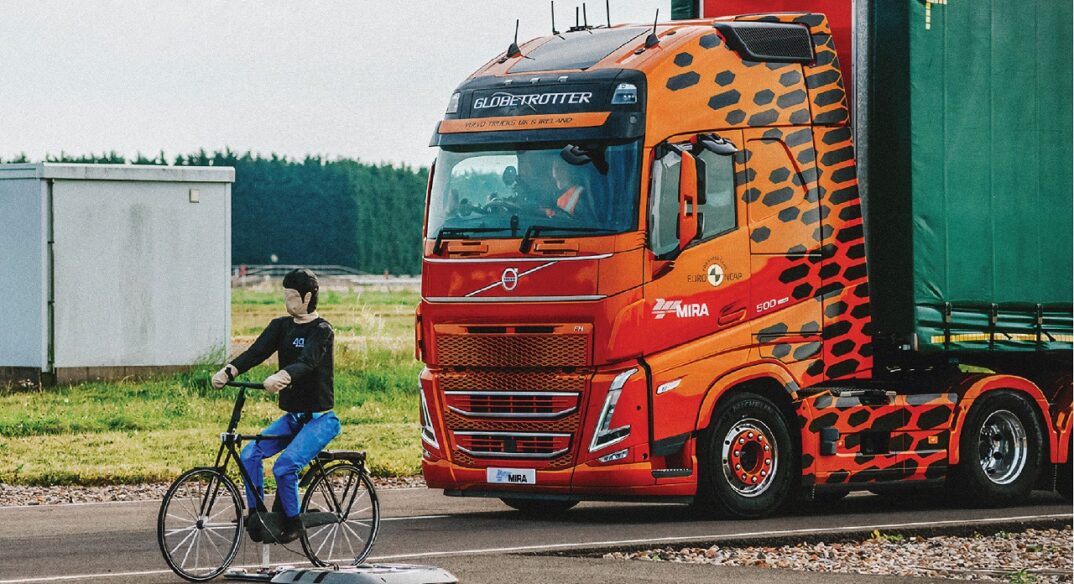Euro NCAP is turning their road safety focus clearly towards the heavy truck sector, as road death statistics tell us that trucks represent only 3% of vehicles on Europe’s roads but are involved in almost 15% of all EU road fatalities.
Areas Under Test
Areas that the safety body are considering include Intelligent Speed Adaptation (ISA), which could limit truck speeds in a variety of circumstances and road types, not just on motorways. Another important area is Autonomous Emergency Braking (AEB) and, whilst it has been available on trucks for some while, the effectiveness of the systems are below that of passenger cars meaning that improvements can be made. Offering an AEB system that detects Vulnerable Road Users (VRU) more widely than the one manufacturer at present could save lives.
A Lane Support System, (LSS) would help in the fatalities arising from trucks veering out of their lanes. Instead of just a warning, a system to actively steer the truck out of the way will be tested by Euro NCAP.
A significant area for urban tipper operators could be improved using better Nearside Turn AEB and Move Off Prevention systems. Direct vision standards are playing a part here, but systems are to be tested that can continuously monitor for cyclists and pedestrians scanning the existing blind spots.

The Next Steps
Euro NCAP’s future rating scheme is designed to go further and faster than current EU truck safety regulations, while also driving innovation and balancing the needs of the different commercial vehicle sectors across Europe.
Dr. Michiel van Ratingen, Secretary General Euro NCAP said, “Today marks a significant moment in the development of Euro NCAP’s Truck Safe rating scheme. Sadly, when trucks are involved in crashes, their size and weight mean there is a greater risk of fatalities – especially for more vulnerable road users (VRUs). Euro NCAP today highlights the need for trucks to be better equipped with life-saving technologies, particularly related to crash avoidance, vision, and aspects of post-crash rescue. The protocols announced today will be formally published next month and demonstrate that best practice test methods developed over the last decade for passenger cars can be turned into useful guidelines for the design of future, safer heavy trucks. By publicly presenting the procedures and requirements ahead of the rating, we hope that the industry will take note and react accordingly. At NCAP24, we are delighted to be joined by key stakeholders in the industry and vehicle manufacturers including DAF, Scania, Volvo, and ZF who are demonstrating their state-of-the-art technologies.”
Matthew Avery, Director of Strategy Development Euro NCAP commented, “Over the past 12 months, we have worked closely with vehicle manufacturers to develop the tests and consulted with different stakeholders across Europe including distributors, hauliers, insurers, city authorities, legislators, and strategic road organisations to fully understand the complexities of making trucks and roads safer.
The future Truck Safe rating will incentivise good safety performance in both cities and highways and allow optimisation of operational safety and cost. New regulatory requirements have forced manufacturers to increase safety performance. However, our aim is to progress towards best practices in all types of vehicle safety, rather than just meeting minimum standards, a goal we have successfully achieved with passenger cars.”
Accidents between trucks and vulnerable road users (VRUs) currently account for 25% of all EU fatalities. Truck accidents vary significantly depending on the type of road environment (City or Highway) as well as the collision partner (passenger car or VRU). The new tests will emulate real-world collisions and encourage manufacturers to fit collision avoidance technologies and improve driver vision. In the future, Euro NCAP will expand the programme to include crash protection as well. The approach taken by Euro NCAP is designed to highlight technologies that are both cost-effective and deliver on safety and allow operators to select the safest vehicle for a particular role.
Ulric Långberg, Swedish Association of Road Transport Companies commented, “Road transport plays an integral and vital role in our economies. Safer roads are key to this, but it’s complex. There isn’t one solution. It’s about taking a holistic approach to making both trucks and roads safer: from driver behaviour and monitoring; to road infrastructure; to adopting assisted driving technologies currently available on cars; and looking at the structure of trucks and how they perform in accidents.
The sooner we recognise that safety technologies on trucks lag behind those on cars, the quicker we will be able to reduce the number of fatal accidents involving trucks.”
As manufacturers respond to the tests, the requirements will evolve. In 2027, increased active safety requirements around manoeuvring will be required; then in 2030, Euro NCAP will start the crash testing of trucks to encourage better passive safety protection. The vehicles will be tested by sector and will focus on city delivery, highway distribution, long haul, and tipper and refuse trucks. The first release of ratings will be announced in November 2024.
Matthew Avery continues, “Euro NCAP Euro NCAP’s new Truck Safe rating scheme will be a first for the sector and will enable all stakeholders in the freight industry to identify and assess the safety level of trucks. Not only will this deliver enhanced safety for drivers but also create opportunities for those operators that invest in the safest vehicles, making the scheme attractive to insurers and freight shippers alike. In creating a market for safety, Euro NCAP will encourage manufacturers and suppliers to innovate, further increasing the safety benefits of the scheme as the ratings evolve.
Cities and regional authorities will be able to clearly identify the best vehicles for their roads and incentivise adoption, and companies will be able to easily determine the safest vehicle suitable for the role. The new rating builds on Euro NCAP’s successful Light Commercial Van safety scheme – enhancing Euro NCAP’s messaging for fleets and businesses: Safer Vehicles = Safer Profits.”
All protocols and requirements are being developed in collaboration with Euro NCAP members, and test facilities and reviewed with manufacturers.
